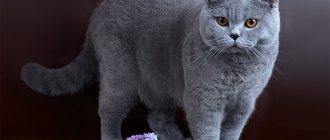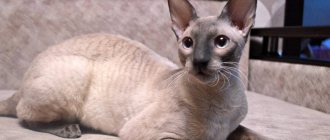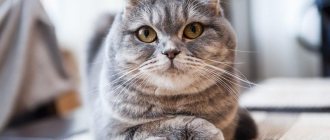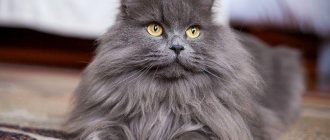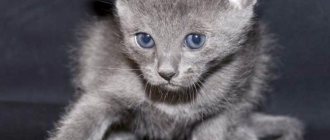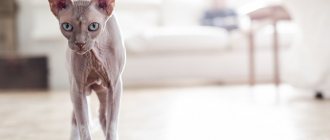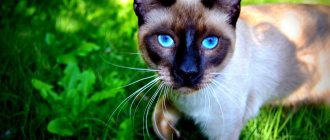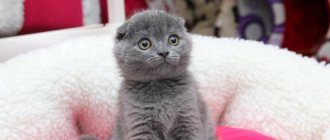History of the Singapura cat breed
The wild ancestors of the Singapura cat lived on the island of Singapore and were not very revered by the local population, since they lived mostly in ditches and drainpipes. After the Singapore government reconstructed the sewer system, a significant part of the population of these animals died.
This is what a wild Singapore cat looks like
And it is unknown how their fate would have ended if geophysicist Hal Meadow had not ended up on the island around this time on official business. The scientist’s wife was a felinologist and at that time even a CFF judge, so he immediately drew attention to unusual cats. The story goes that he sent four animals (three cats and one tomcat) to his wife Tommy in the United States in 1971. The woman began breeding a new breed, but did not keep any records regarding matings. In 1974, the descendants of the first Singaporeans were taken back to their home island, where the Meadows went to work.
A year later, these cats were first presented at an exhibition in the USA. In the 80s, several more individuals of this breed were imported and took part in the development of the gene pool. But the official date of birth of the breed is considered to be 1975, because due to the confidential nature of his husband’s work, Tommy had to hide the true state of affairs and the origin of his pets.
As a result of selection work, the color of the Singapura has become more even
Since Tommy was a breeder of Burmese and Abyssinian cats, there have long been rumors that the Singapura is not a natural breed, but was developed as a result of crossbreeding.
The Singapura breed standard was described in 1981
Be that as it may, the breed was standardized in 1981. In the mid-80s, it was officially recognized by many phenological communities. Singapore received championship status in 1988.
The author does not guarantee 100% accuracy of the information provided, since other breeders also took part in the formation of the Singaporean cat breed. Perhaps their contribution was more significant. But I think this is not particularly important for ordinary cat lovers.
Animal temperament
Singupuris are cautious with strangers, they are in no hurry to get to know each other, but they also do not shock them with their crazy antics. Pampering is not their style. They flirt when it is expected of them. Breeders note the friendly nature of Lilliputians. They know how to show their tenderness in response to shown care. However, they always remain unconvinced and make decisions independently.
They are particularly caring; if there are children at home, they will take care of them. They lead an active lifestyle, even if no one pays attention to them, they have fun. They get along with other animals: dogs, cats, parrots, hamsters.
The breed is characterized by a lack of aggression. The kitten will always find something to do or simply go to rest.
Easy to train, quickly begins to respond by name. Excellently picks up the owner's commands. The cat meows quietly and does not cry unnecessarily. Lilliputians are ready to accompany the breadwinner on their heels, they love to sleep nearby and bask
The miniature beauty knows how to attract the attention of adults and children
The Singapura cat can play if it is expected of her.
Singapuras get along well with other cats
Description of the Singapore cat breed
It is quite difficult to describe Singapura cats in words; even photographs do not fully convey their charm. All owners claim that an unusual glow emanates from their pets.
Appearance of a Singapura cat
Island Singapore cats are small, slender and elegant. But their bones are strong, and their stocky, slightly elongated body has a well-developed muscular system.
Singapura has a small but muscular body
According to the Singapore standard, the following breed characteristics are inherent:
- the body is rectangular, slightly angular;
- powerful limbs of medium length with small, very neat, graceful paws ending in a medium-sized hard pad;
- the neck is short and quite powerful;
- weight: females – 2–2.5 kg, males – 2.5–3.4 kg;
- the head is small and round with a short, well-defined chin;
- the blunt, small nose is in line with the chin;
- large ears are wide open at the base, spaced not very far from each other, the tips are slightly pointed;
- very large, slanting, almond-shaped eyes, with a noticeable slant towards the outer corner, wide open, not sunken or bulging, a distance of at least the width of the eye is allowed between the eyes;
- eye color is green or yellow, as well as greenish-yellow without black, red and gray impurities;
- the expression in the eyes is always a little surprised;
- the tail is not very long and thin with a blunt tip; if it is placed along the cat’s body, it should reach her shoulder girdle.
The coat of Singapura cats is short, without undercoat and lies close to the body. The coat is thin and shiny, not too soft, but not harsh either. Small kittens may have softer, silkier fur.
A Singapura cat can have only one color - sepia agouti.
The acceptable color according to the CFA standard is exclusively sepia agouti - on a base light tone, close in color to ivory, with dark brown ticking. Each hair must be light at the base (near the skin) and always dark at the end, and also have at least two dark stripes alternating with light ones. The tip of the tail is brown with a smooth transition to the back. A dark stripe along the ridge is allowed. The muzzle, chest, chin and belly are a very light warm brownish shade. Dim stripes are present on the inside of the front legs and on the knees of the hind legs. Between the brownish-pinkish paw pads are tufts of dark brown fur.
The color of the nose mirror varies from light salmon to dark. Brown edging on nostrils, eyes, lips and whisker pads. The fur on the cheeks is also dark. The face has a characteristic cheetah pattern, with brown lines located at the outer edges of the eyes and eyebrows, and also running down to the nose from the inner corners of the eyes.
The Singapura cat has a very cute face
Singapura cats are very rare and expensive, so you rarely see them at shows. We only saw a cat and kitten once. They gave the impression of some kind of toy and caramel creatures. The mother cat herself is small, a little larger than a kitten of an ordinary cat, and her cub is generally tiny. The eyes are completely unreal, no living creature has such a look. The coat is thin, as if sleek, but at the same time has a very healthy shiny appearance. The owners did not allow their pets to be touched, probably because they were afraid of injuring the delicate cat’s psyche.
Personality of the Singapura cat
Singapura cats have a very active, playful and restless character. This breed retains a love for outdoor games throughout its life. Singapura is always on the move and it seems that fatigue is unknown to her. As an entertainment companion, he can choose another pet living in the same territory. It doesn’t matter who it will be - a dog, a bird, or even a hamster. This cat can easily find a common language with any animal. You can leave them with children completely calmly; they will humbly endure all children's pranks and will never offend their little owners.
Singapura cats constantly run and play
Aggression is unusual for this breed; all its representatives are friendly, gentle, affectionate and flexible. They quickly become attached to a person and try to relentlessly follow their owner, keeping him company in all household chores. Thanks to their developed mental abilities, Singapura cats are capable of learning, are well trained, quickly remember their nickname and easily carry out the simplest commands.
Singapura very rarely meows. She only shows a quiet and gentle voice in emergency situations.
Despite all their loving nature, these animals are completely unobtrusive. They understand when their owners are not interested in them and during this time they are able to occupy themselves. But as soon as one of the family is free and sits down to rest for a minute, the Singapura immediately materializes out of nowhere and sits on its knees.
Singaporeans are very inquisitive and curious.
Island cats are curious, like all cats. They love to survey all their surroundings from the height of a closet or refrigerator; their small size does not at all prevent them from climbing and jumping well. They behave extremely carefully with unfamiliar people and objects. Cats need time to get used to new things. They will sit in a safe, secluded place and carefully observe the events taking place. Realizing that there is no danger, the pet comes out of hiding, but will behave warily.
Singapura cats are sensitive and shy, so do not make noise in their presence. They absolutely cannot tolerate excessive fuss and loud noises. Quarrels, shouting and swearing will be a great stress for them and will force them to hide in the farthest corner.
We have a Siamese cat living at home, which has a distinctly Singaporean character. Nature made a mistake with its colors. He shudders and looks around at any sounds, hides under the sofa or in his house from strangers. But at the same time she is not at all cowardly, but rather cautious. After some adaptation, she is quite loyal to strangers, but she will never be picked up herself.
Character
The Singapura cat is an affectionate, sociable, tame pet. They love their family and hate being alone for long periods of time. Purring on your knees, running races with a child, watching the peeling of potatoes - it’s all the same, just to remain part of the family. Even strangers are welcome, welcoming guests with interest.
Like Siamese cats, Singapuras love to participate in household chores, but they are less intrusive and less talkative. Like Burmese, these pets avoid conflict to the last. They are patient even with careless children, without releasing their claws. Like Abyssinians, they are always ready for active games and are very curious.
The latter often causes injuries. Therefore, especially at first, the house must be secured as much as possible. A Singapura kitten can harm itself by getting tangled in a curtain or hiding in a gap between a wall and a closet. Like all oriental breeds, they often fall out of windows, so it is advisable to strengthen mosquito nets.
The Singapura cat gets along easily with other animals if they are friendly. Their pliable, gentle nature makes them suitable for any family, except those who are constantly away from home. Without attention, a small cat will cause big problems, reminding its owners of its eastern roots.
Purchasing a Singapura kitten
The number of purebred Singaporean cats in the world is small. This breed is more popular and widespread in the United States of America. There are very few specialized nurseries in Europe. But nevertheless, you can find kittens. There are several breeders in Russia who professionally breed Singapura.
Buying a Singapura kitten is very difficult
Criterias of choice
It is almost impossible to confuse Singapura babies with another breed, because their size is much smaller than other kittens of the same age. Their color develops very early and the cubs look like adult animals. The only thing is that the fur may be a little longer, fluffier and softer to the touch.
You should purchase kittens only from reliable breeders with a good reputation or from specialized nurseries. You immediately need to decide what class of pet you need. If a show-class animal with the right to exhibit is required, the seller must provide a pedigree confirming at least four generations of Singapore. The cost of such individuals is very high and can reach up to 150 thousand rubles and more. A pet class (as a pet) will cost several times less. Here everything is determined by existing defects in appearance (lack of stripes on the muzzle, light spots, tail defects, etc.). In this case, the purchase and sale agreement will necessarily contain a clause on the need to sterilize or castrate the animal (prohibition on breeding).
Small kittens have longer and softer fur
Before making a decision, you should definitely meet the parents of the future pet. They must visually look like island Singapore cats and have documented evidence of this fact.
I advise experienced cat breeders to pay attention to the following factors:
- the eyes and ears look healthy, they are clean and do not have any suspicious discharge;
- the fur is silky and soft, without rolled or stuck together areas;
- teeth are straight and white;
- the tummy is soft, with slight pressure on it the baby does not experience much discomfort;
- the animal may be a little timid (this is typical for the breed), but not excessively;
- the kitten should look healthy (do not cough, sneeze, rub its eyes, etc.).
Kitten age
Small island cats develop relatively slowly, so kittens are given away no earlier than 3–4 months. If the pet is expected to move a long distance (to another city, country, etc.), then the cubs are separated from their mother after 4–4.5 months.
Kittens are given away no earlier than 3–4 months
conclusions
Singapuras are mischievous, curious, sweet furry friends who will do whatever it takes to bond with their favorite people. If you've been looking for a pet that will challenge the stereotypical feline aloofness, Singapore is the place to be. Although these cats may be a little wary of strangers at first, owners will tell you that they are not shy or timid at all.
They will be happiest in a home with a large family, in which everyone is ready to give them love and attention. If your family spends a lot of time outside the home, it may be best to hire a pet sitter. Then the pet will definitely not feel sad.
Singapore cats are famous for being the smallest breed in the world. They also have a truly unique coat color throughout the cat community. However, if you get to know the Singapura more closely, you will notice that it is their wonderful character that sets them apart from other cats.
Based on materials from www.madpaws.com.au
Keeping a Singapura pet
Singapura cats do not pose any particular difficulties in keeping. But this breed absolutely cannot tolerate low temperatures and drafts; a tropical climate suits them much more.
Nutrition
The Singapura does not have any special complaints about feeding, apparently it is due to the past hard life and feeding on garbage. These cats will happily consume both ready-made cat food and natural food.
Quantity and composition of food
The Singaporean breed is not prone to overeating and obesity. Excessive activity and mobility allows them to completely use up the calories they consume and not put anything in reserve. This animal will not eat more than it needs. He is not particularly gluttonous or insatiable. The recommended amount of feed is no more than 25–30 g per 1 kg of live weight.
It is recommended to feed Singapore cats with premium food
The natural menu of island cats should include the following products:
- boiled or pre-frozen and thawed meat (fillet - rabbit, turkey, lean beef);
- cereal porridges (barley, rice, buckwheat, rolled oats, etc.);
- quail eggs;
- low-fat cottage cheese and sour cream;
- boiled vegetables (beets, carrots, potatoes, cabbage, etc.);
- fruits (bananas, peaches, mangoes, etc.) as a treat.
Singapura cats can be given fruit as a treat.
Experienced breeders advise choosing cat food containing no more than 30% meat component and with high digestibility (not lower than 80%).
It is necessary to have clean drinking water available in the area, which is changed daily.
How many times a day should you feed your pet?
Babies are first fed 5-6 times a day with special wet food for kittens . Then they are gradually transferred to adult nutrition and the number of meals per day is reduced to two times.
Small kittens are first fed with special food, and then gradually transferred to adult food
The role of a balanced diet in cat health
For the harmonious and proper development of such small cats, a balanced diet is of particular importance. Incorrectly selected food can slow down the development and growth of a small pet and even cause some pathologies. An adult cat needs to fully replenish the energy spent on endless running and playing.
The following foods are absolutely contraindicated:
- River fish;
- milk;
- sausages and smoked meats;
- pork;
- pastries and sweets.
With a natural diet, Singapura cats must be given vitamins and minerals.
In addition to natural nutrition, you will definitely need to give your pet mineral and vitamin complexes in addition.
Experienced breeders believe that it is better to opt for premium ready-made food, because it contains all the necessary components for the normal functioning of the cat’s body.
Appearance care
Since Singapore cats are a short-haired breed, caring for them is very simple and does not require a lot of time.
Combing
Island cats are particularly clean; they groom themselves thoroughly and cope well on their own with short, fine fur. To remove dead hairs, comb them no more than once a week with a special brush for short-haired animals. They shed unnoticed by their owners, so no additional measures are required.
Use a soft mitten brush to comb out dead hairs.
To care for our pet's fur, we use a special mitten. The combing process can be significantly speeded up by wearing mittens on both hands. Our cat does not like this procedure, so everything needs to be done quickly and painlessly.
Bathing
Singapura cats do not need to be bathed frequently. It is enough to carry out water procedures once every 2-3 months.
Ear care
Since the ears of this breed are quite large, their condition must be carefully monitored. About once a week, the pet's ears are examined and wiped with a special ear care product (available in stores selling pet supplies and veterinary pharmacies) or chlorhexidine. Using cotton pads and swabs, carefully remove accumulated sulfur plaque and dirt.
Singaporean ears should be regularly wiped with a cotton swab dipped in a special solution.
We examine our cat's ears once every two weeks. Turning the auricle outward, gently wipe the inside with a damp cotton swab. If you can’t remove all the dirt from the folds, then use cotton swabs.
Eye care
It is recommended to wipe your eyes daily . To do this, use cotton pads and special solutions, as well as herbal decoctions (chamomile, calendula, St. John's wort, etc.) or simply warm boiled water.
Eyes and ears can be treated with special wet wipes
On sale you can find wet wipes designed to care for the eyes of animals.
Nail care
The claws of this breed, although small, are very sharp, so they need to be trimmed at least once every 2-3 weeks using a nail clipper (special scissors). It is necessary to provide the pet with the opportunity to sharpen its claws on its own and provide it with a scratching post, or preferably several.
Nails need to be trimmed once every 2-3 weeks
Singaporeans are unusually restless and active, so they need to purchase large multifunctional play complexes. They should have a lot of different toys, ladders, hammocks and beds, as well as scratching posts, tunnels, shelter houses, etc.
Dental care
To maintain healthy teeth, it is recommended to brush them 2-3 times a week using a soft brush and a special paste for animals that does not need to be washed off. It can be found on the shelves of large shopping centers, in specialized pet stores and veterinary pharmacies.
Your cat needs to brush its teeth at least once a week.
Toilet
Many owners of Singapura cats note their amazing cleanliness. They very quickly learn to relieve their natural needs in their potty. Any tray design will do. But it is better to purchase a closed version, since these shy animals love privacy at such moments. The choice of filler depends on the personal preferences of the owner and taking into account the wishes of the pet. At the initial stage, small kittens are advised to sprinkle paper or wood granules; they will not cause harm if accidentally swallowed.
For Singapura cats, it is better to purchase closed trays
The Singapura, despite its small size, can learn to sit on the toilet on its own. To help her learn, you can use a special pad.
We have always used pine litter for all our cats. It smells nice, absorbs odors well and is very inexpensive. Several times we tried to offer the cat other granules (clumping litter), but she flatly refused to walk in them and kept trying to sit down next to the potty. I had to meet her halfway.
Walks
Singapore does not need walks in the fresh air. But if suddenly your pet develops such a need, then you need to monitor the weather and, if necessary, dress him warmly. These heat-loving animals get cold very quickly.
Nutrition
Singapuras are one of those breeds that can eat as much as they want without getting fat. But this does not mean at all that they can be fed with anything, especially with food from our table. Pork, lard, river fish, smoked sausages, whole milk, cream, spices - all this should be strictly prohibited.
If you are going to feed your cat natural products, give preference to lean chicken or turkey meat, boiled liver, and offal. Occasionally, you can treat your pet to a piece of sea fish, but you should not include it in the daily diet: in large quantities, fish can provoke the development of urolithiasis, from which cats suffer greatly and often die.
Meat should make up about a third of your daily diet. It is preferable to give it minced and mixed with porridge cooked from one or several types of cereals: rolled oatmeal, buckwheat, rice. An excellent addition would be boiled vegetables: potatoes, cabbage, beets, carrots, zucchini, all types of legumes. They can be cooked separately or together with meat, so the cat will eat them even more willingly. Many animals eat fresh cucumbers and green peas with appetite.
Kefir and low-fat or low-fat cottage cheese are very useful for cats. They are indispensable as a source of calcium, are well absorbed and help digest heavier foods.
It will be more convenient for busy owners to feed their pets with ready-made super premium and premium food. They are perfectly balanced and completely ready to eat.
Fresh water should be available to your cat at any time of the day.
Wash your pet's bowl thoroughly with hot water every day. You should not use dishwashing detergents: the smell is almost imperceptible to us and can take away your cat’s appetite for a long time. In addition, insufficiently thoroughly washed off remnants of this liquid often cause nausea, vomiting and stomach upset.
Defects of the Singapura cat breed
The gene pool of this breed is very small, so the phenomenon of inbreeding (inbreeding) occurs frequently. In this regard, there are a number of defects and genetic pathologies.
Tendency to diseases
The lack of genetic diversity in the Singapura cat leads to the following health problems:
- Infertility.
- Inertia of the uterus. The muscle tissue contracts poorly, as a result of which the animal cannot give birth on its own. Natural childbirth is impossible, so the cat has to undergo a caesarean section.
- Tendency to colds (low immunity). The temperature rises, mucous discharge appears from the nose and eyes, the animal coughs and sneezes. There is general lethargy.
- Pyruvate kinase deficiency. A genetic disease associated with a deficiency of a special glycolytic enzyme and leading to hemolytic anemia. It is expressed in a decrease in appetite, general lethargy, hair loss, etc. Sometimes it is possible for the rapid development of severe anemia, which threatens the life of the pet. Clinical manifestations become more noticeable in older animals.
Defects in appearance
The following signs are considered to be the following signs of appearance defects in Singapura cats:
- elastic, too soft or long coat;
- coat of cool or gray shades;
- stripes on the outside of the limbs;
- dark color of hairs near the skin;
- palpable but visually invisible tail defects.
Strict requirements are imposed on the appearance of the Singapura cat.
Singapore has a number of appearance defects that do not allow participation in exhibitions and lead to the disqualification of the animal:
- Blue eyes;
- White spots;
- clearly visible tail defects;
- lack of ticking on the head;
- transverse stripes (rings) on the tail;
- small eyes and ears;
- stripes-necklaces on the neck and paws;
- any color except the standard breed (sepia agouti).
Breeding the Singapura cat breed
Due to their small numbers, breeding the Singapura cat presents some difficulties. The breed is considered mature and established, therefore crossing with other breeds is strictly prohibited.
Criteria for choosing a partner
You should choose a pair for your pet very carefully to avoid inbreeding. A responsible breeder will try to avoid the transmission and preservation of bad genetic inheritance in the offspring. To do this, you need to have information about the potential partner’s closest relatives, exterior qualities, diseases and genetic disorders (if any).
The selection criteria are as follows:
- strict conformation to all breed standards;
- good health and absence of aggravating pathologies;
- balanced and stable psyche;
- availability of necessary vaccinations (they are given in advance 2–3 months before mating);
- pedigree (preferably up to the fourth generation);
- breeding clearance (required).
Finding a partner for a Singapura cat is not easy at all.
If possible, it is advisable to look at the offspring that this manufacturer already has.
At what age should you give your pet for the first mating?
Singapore cats develop slowly and reach sexual maturity at about two years, males a little earlier. Veterinarians advise mating females closer to three years, and males after 2–2.5 years. It is highly not recommended to knit them before.
The cat’s body has not yet fully formed, so there may be difficulties both with the birth itself and with the offspring. Kittens may be born weak and even non-viable.
Quite a long time ago we had a cat (also Siamese). She lived a free life, walked wherever she wanted and looked for partners for herself. It so happened that she became pregnant while she was still practically a kitten. She was 7–8 months old at that time. She was unable to bear offspring and had a miscarriage. Then she was sick for a very long time and came to her senses. All subsequent pregnancies were surprisingly easy and without any negative consequences.
A Singapura cat usually gives birth to 3–4 kittens.
How often can a cat give birth?
It all depends on the physical characteristics of the animal itself. Most experienced breeders and veterinarians advise breeding cats no more than 1-2 times a year.
With Singapore, given the problems with labor, everything is somewhat more complicated. If there was a caesarean section, then you should not breed the female again before 2–2.5 years. If the birth was natural, then you can follow the general recommendations of veterinarians.
Diseases
Despite its external fragility, this breed is considered one of the healthiest. She currently has no known genetic diseases.
But short fur does not retain heat well, so it is important to ensure that your four-legged friend does not catch a cold. Protect your pet from drafts, do not allow him to sleep under an open window, dry with a hairdryer after water treatments, and for walks on cool days, be sure to buy a warm cat suit
Vaccinations and deworming are mandatory procedures if you care about the health of your big-eyed furry. Modern vaccines (Quadricat, Nobivak, Leukorifelin, Multifel) make it possible to protect an animal not from one, but from several dangerous diseases at once. The first vaccination is given at 9-12 weeks (at 6 weeks if necessary), then once a year.
Deworming is carried out once a quarter. Exceptions: kittens under 6 months, pregnant women, animals with infectious diseases.
Castration and sterilization of Singaporeans
Animals that do not meet strict conformation standards and are not intended for breeding must be spayed or neutered.
At what age should surgery be performed?
On average, females of almost all breeds are advised to undergo surgery at 8–12 months. It’s better to do it before the first heat, but you can do it later. There is no need to delay it too much; it is advisable to do this before two years. Males are operated on between 10 months and 1.5–2 years.
Considering the late stages of puberty in Singapore cats, all dates can be safely shifted by at least 8–10 months.
The older the animal, the more difficult it is to tolerate surgery. The risk of negative consequences increases. If castration or sterilization is done too early, the pet's development may be delayed.
Caring for your pet after surgery
Not all pets tolerate surgery equally well, so after surgery, in order to avoid negative consequences and complications, it is necessary to carefully monitor the animal.
Proper care after castration and sterilization is as follows:
- provide your pet with peace and quiet;
- immediately after the manipulations, put on a special “Elizabethan” collar or postoperative blanket;
- remove the bandage and treat the stitches with chlorhexidine, hydrogen peroxide or other disinfectant at least once a day;
- Do not feed for 10–12 hours after surgery;
- limit the pet’s mobility and do not allow him to pull off his blanket and collar.
After spaying or neutering surgery, it is necessary to put a protective collar or post-operative blanket on your pet.
If the stitches begin to get wet and fester, or the pet looks bad, refuses food for more than three days, or in any other alarming situations, you should immediately contact a veterinary clinic.
Pros and cons of the Singapura cat breed
| pros | Minuses |
|
|
Reviews from owners of Singapura cats
I recently became the happy owner of a Singapore. Two miracles appeared in my life: the cat Vera and the cat Petya. They made friends with us surprisingly easily and quickly and joined our cat family (I also have Scottish Stripes and Scottish Folds at home). Now we cannot imagine that we once lived without them!!!
Singapore
https://forum.cats-paradise.ru/singapura-heart-t846.html
the cat is very well-mannered and adequate in relation to the apartment: she recognized the tray (silica gel) immediately and never cheated on herself; doesn’t tear up curtains or furniture (although she sometimes confuses old green chairs with a scratching post), doesn’t chew wires at all, is indifferent to houseplants (although she loves special grass for cats); She eats dry food in small portions as needed, as if she were reading her daily intake on the bag. Well, aggression - no, we haven’t heard of it.
Alakuloinen
https://irecommend.ru/content/boginya-podruga-psikholog-i-massazhist
It is easy to care for and does not require walking outside at all. Short hair does not need to be combed. The breeders said that they (cats) are afraid of the cold, but I didn’t notice it. It doesn't do much mischief, but the indoor flowers suffer. Constantly lying somewhere or sleeping, bouts of activity are rare. The cat is quiet, calm, without outbursts. Children may be bored with her. Terribly cowardly and cautious. With friends she is affectionate and gentle. She looks terribly cute and cute.
svetadalari
https://irecommend.ru/content/miniatyurnye-koshechki-fotki-moego-koshkopupsa
I specifically emphasized that the problem is not the size, but the position of the ears. In general, the Singapura is a variation of the common cat. Never a Cheburashka-orik or a freak-lefty. In a way, we are also street people. In any case, the official origin legend takes us back to the “gutter cats.”
TMP
https://forum.awd.ru/viewtopic.php?f=367&t=186071
Photo gallery: Singapore cats
The Singapura cat's eyes are always a little surprised
Even adult cats love to play with their beloved owner
Singaporean cats are silent and meow only in the most extreme cases.
There is a very warm relationship between cats and kittens.
The Singapura has a characteristic cheetah-like pattern of dark stripes on its face.
Singapura cats are constantly on the move and playing.
Kittens can play with any toys
Singapore cats are very curious
Currently, the Singapura cat is a symbol of its historical homeland and now it is prohibited to export these animals outside the country. Although wild animals still living in Singapore are slightly different in appearance from their purebred foreign counterparts.
Care
Singapuras have a short, soft coat that requires little grooming. Brush it with a soft bristle brush about once a week to keep it shiny and beautiful.
You can also use special oral hygiene products. Be sure to take your cat to the vet regularly for dental checks and do your best to keep them clean.
